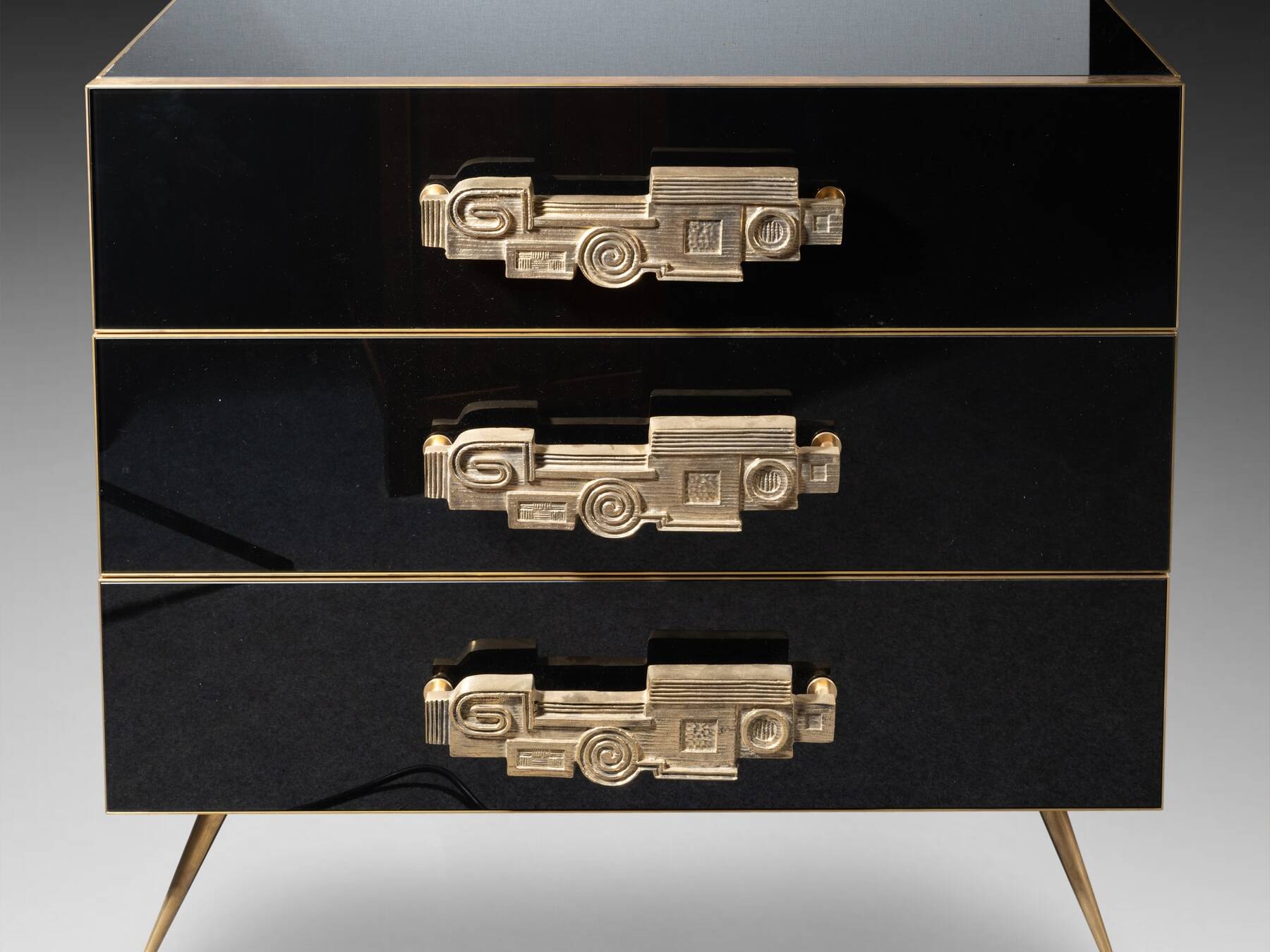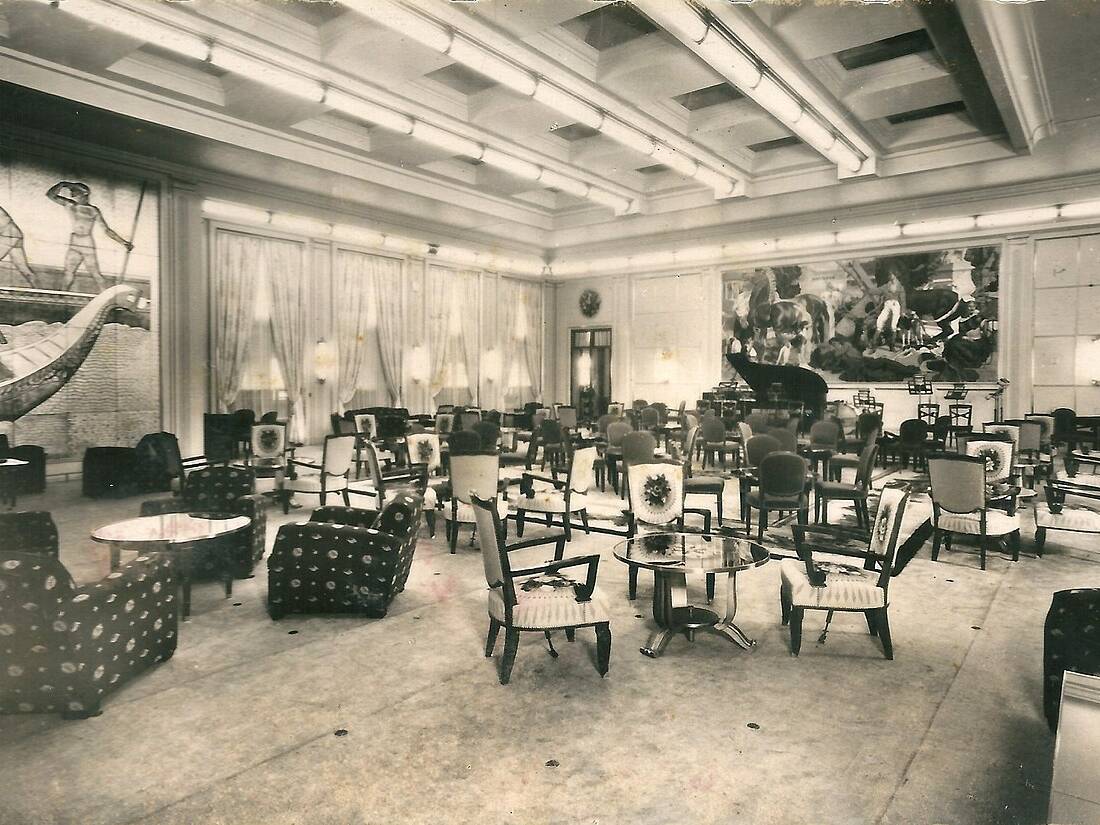Ceramist and sculptor, Luca della Robbia would certainly not have disavowed our copy which is undoubtedly inspired by the habit that the artist himself had of preserving his works in terracotta.
Luca della Robbia (1399 - 1482): the greatest classicist of the 15th century
If we stick to the Lives of Vasari, we must first consider the error of the biographer who makes the artist born 11 years earlier than necessary. We learn all the same thanks to him the details of his apprenticeship:
He was brought up there [A/N in the house of his ancestors] with care, until his father placed him with Leonardo, son of Ser Giovanni, who was considered the most skilful goldsmith there was then in Florence. After having learned, under the direction of this master, to draw and to model in wax, Luca grew bolder, and attacked marble and bronze with such success that he left goldsmithing to devote himself entirely to sculpture.
Vasari, Lives of Painters, Sculptors and Architects, Just Tessier, 1841, Volume 1 and Volume 2.
Quickly, the line became classic, sober and restrained. He already excelled in this elegant sculpture on the bas-reliefs he sculpted to adorn Giotto’s bell tower. One sees there, reports Vasari, “Grammar represented by Donato, Philosophy by Plato and Aristotle, Music by a lute player, Astrology by Tolomeo, and Geometry by Euclid. Today, the Museo dell’Opera del Duomo also preserves Metallurgy and Pedagogy, also the work of della Robbia.
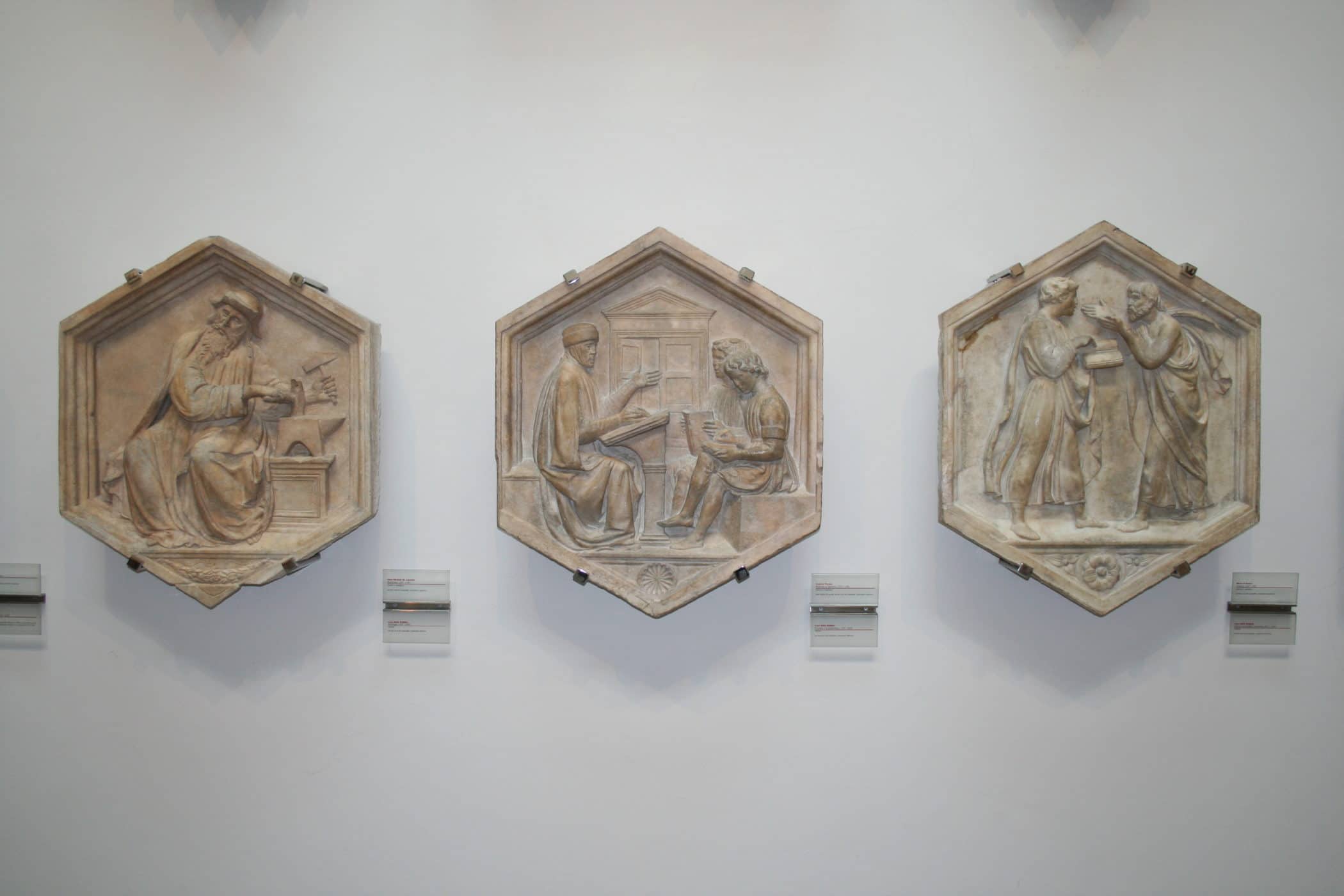
Della Robbia’s sobriety, both in form and in line, places him at odds with the artists of his time. More sensitive to the Apollonian spirit, della Robbia loves nothing more than moderation and mastery, order and simplicity. Opposite him – which will be almost literal in the choir of Santa Maria del Fiore – a Donatello (1386 – 1466), a master in an expressionism determined to single out the figures, to translate an inner personality and not the ideal of an emotion, will appear in a style leaning towards the Dionysian.
The choir of the Cathedral of Santa Maria del Fiore in Florence
Let’s continue reading Vasari:
In the year 1405, the churchwardens, recognizing the merit of Luca, and yielding to the advice of Messer Vieri de’ Medici, who was very fond of him, entrusted him with the execution of the marble ornaments of the great organ which was then being built, and which was placed above the door of the sacristy of Santa-Maria-del-Fiore. Luca formed his base of Choirs of Musicians and Singers, which he treated with such art that one can easily distinguish their slightest movements, although they are raised sixteen fathoms from the pavement of the church.
Vasari, Lives of Painters, Sculptors and Architects, Just Tessier, 1841, Volume 1 and Volume 2.
What Vasari does not (yet) say is that the installation was shared between two geniuses of Renaissance sculpture. Luca della Robbia obtained the order that would overhang the door of the sacristy of the Masses – work that occupied him from 1431 to 1438 – while Donatello was in charge of that which would be placed above the door of the sacristy of the canons, work which required him 6 years of work between 1433 and 1439.
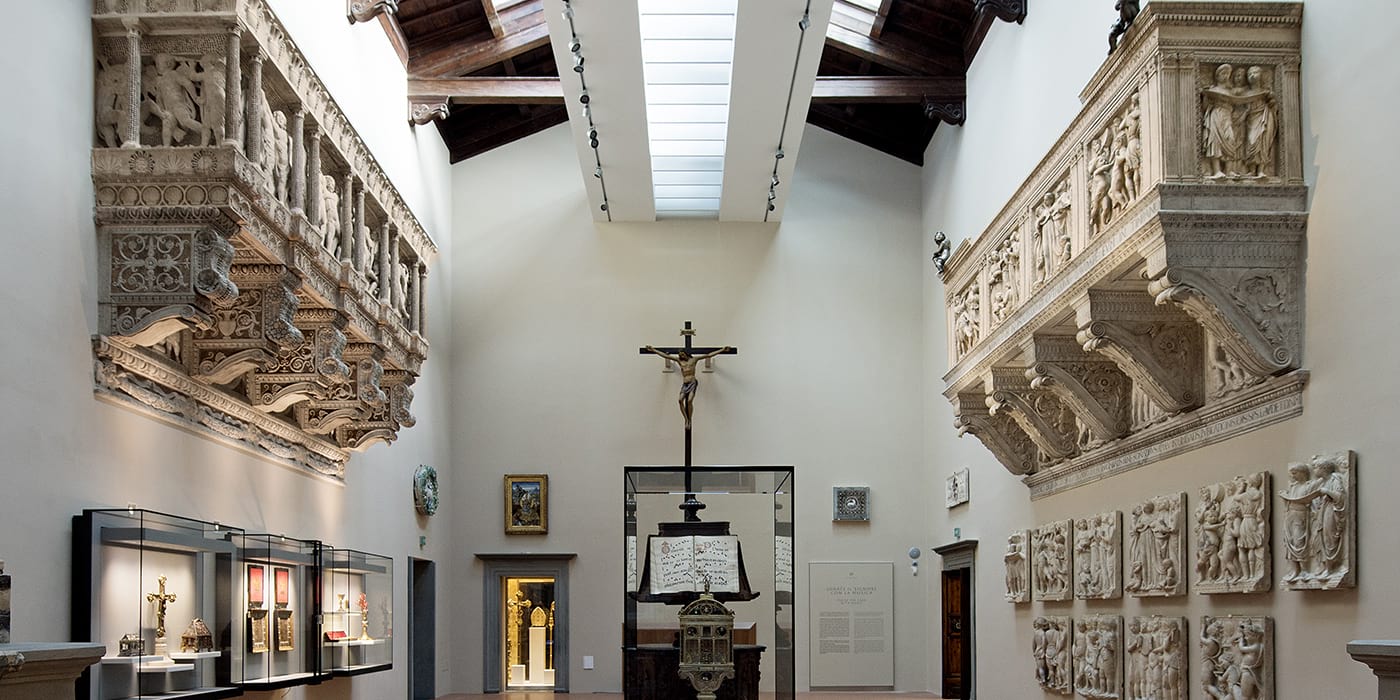
Two artists could not be more opposite and it is enough to admire these balconies presented today at the Museo dell’Opera del Duomo to measure the effect of the confrontation of these two spectacular creations in the very heart of the Florentine cathedral.
Each balcony had to accommodate the singers (cantorie) during the ceremonies. Advantageously installed in height on the balconies of the northeast and southeast pillars of the crossroads of the transepts, singers and musicians were warmly invited to give voice since the arrangement of the cantorie allowed a diffusion – some would say today “in stereo” – of the chants, thus resounding in the ears of all the faithful gathered piously.
Luca della Robbia's Choir: Masterpiece of the Renaissance
Our plaster copy corresponds precisely to the first sculpted frame of Luca della Robbia’s cantoria. On the front of the balcony, four frames are delimited in a sober architectural structure punctuated by pilasters of antique inspiration. This railing rests on five consoles adorned with a frieze of ovals and acanthus leaves. On the plinths and entablatures are engraved the Latin words of Psalm 150, the last of the book of Psalms, entitled Laudate Dominum.
Verse 1 :
Praise ye the Lord ! Praise God in His sanctuary ! Praise Him in the firmament of His power !
Verse 2 :
Praise him for His Mighty acts ! Praise Him according to His excellent greatness.
Verse 3 :
Praise Him with the sound of the trumpet ! Praise Him with the psaltery and harp !
Verse 4 :
Praise Him with the timbrel and dance ! Praise Him with stringed instruments and organs !
Verse 5 :
Praise Him upon the loud cymbals ! Praise Him upon the high sounding cymbals !
Verse 6 :
Let every thing that hath breath praise the Lord ! Praise ye the Lord !
This text, which has been regularly set to music over the centuries, is an invitation to praise God, in particular a recommendation on how to praise God through musical instruments. This is what makes the subject here of the medium reliefs sculpted by della Robbia.
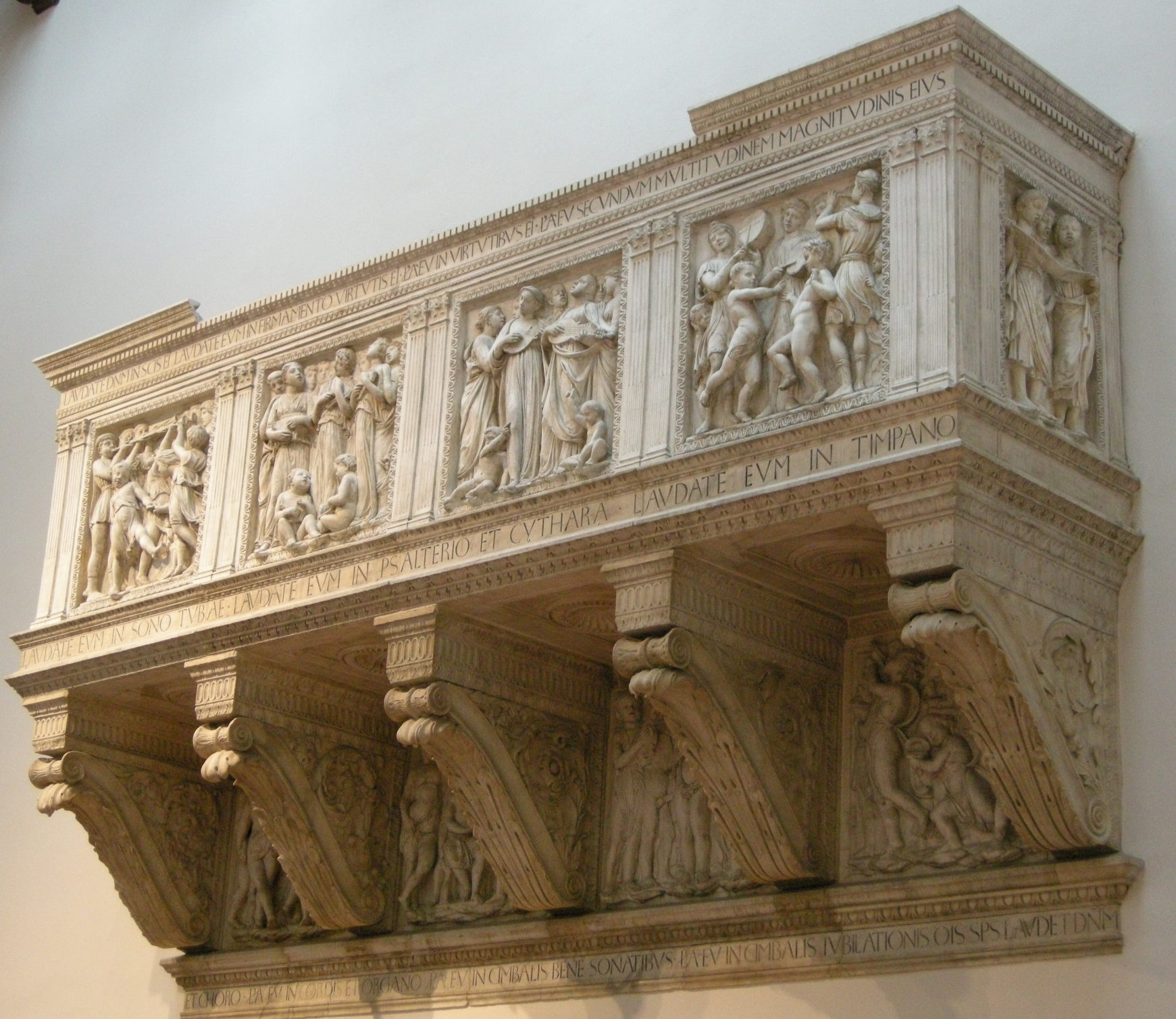
Seven musical instruments are listed in the Laudate Dominum and are indicated for the celebration of the Lord. The trumpet is the first named because it is the instrument par excellence calling for gathering. The lute, the harp and the stringed instruments have melodiously dressed the song since Antiquity and are the first instruments that accompany praise. Percussion instruments (tambourine and cymbals) punctuate the singing while the pipe, a small flute with a melodious sound contrasts with the other instruments and recalls the human voice.
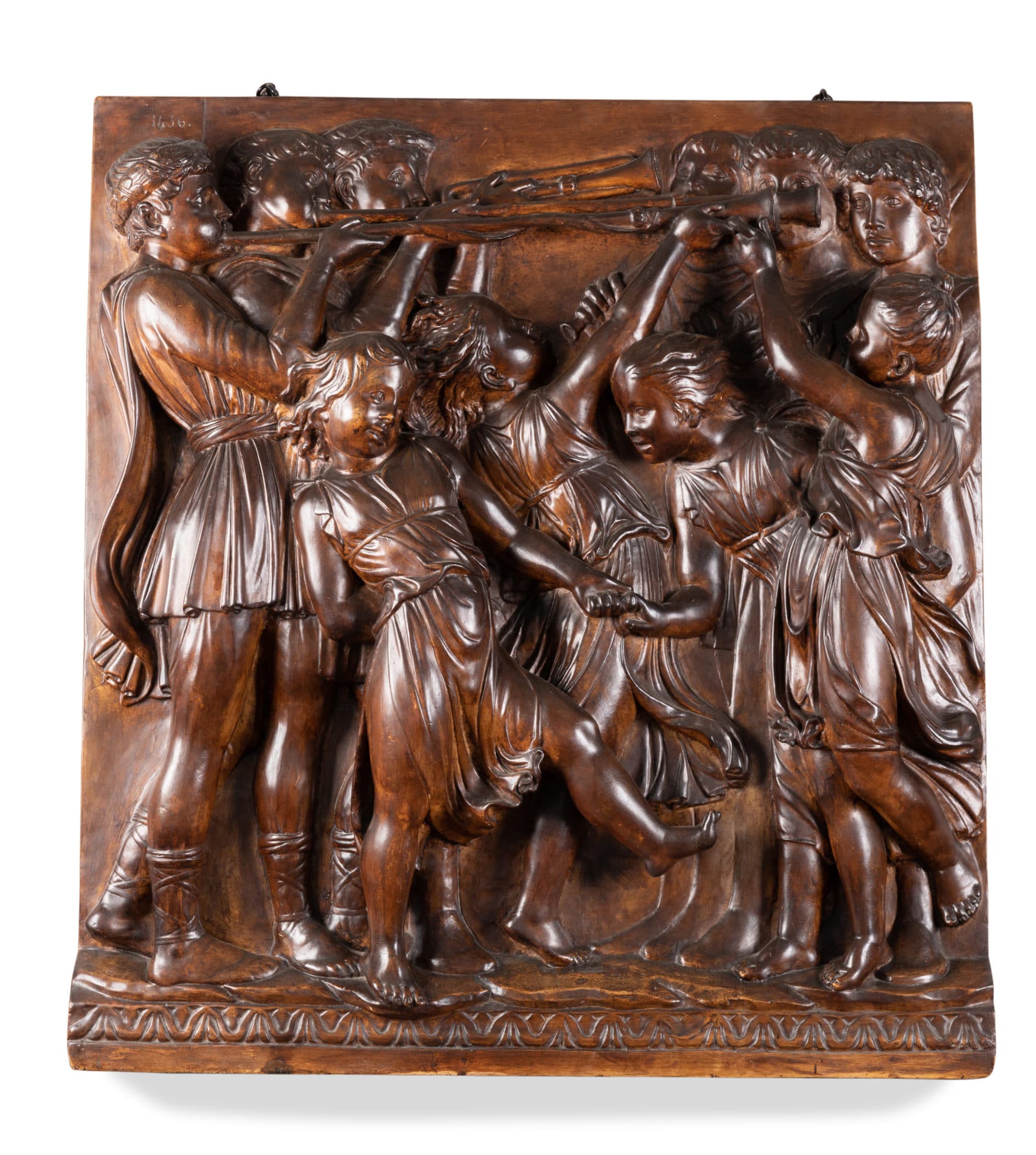
Thus, our bronzed plaster is a faithful copy of this first panel. The spectator finds there a happy restraint in which the charming dances of the children illustrate the joy carried by the Laudate Dominum. To the sound of the trumpets, the bodies come alive and initiate the movement that punctuates the following panels. The layout is in this sense perfectly classic, sober and contained.
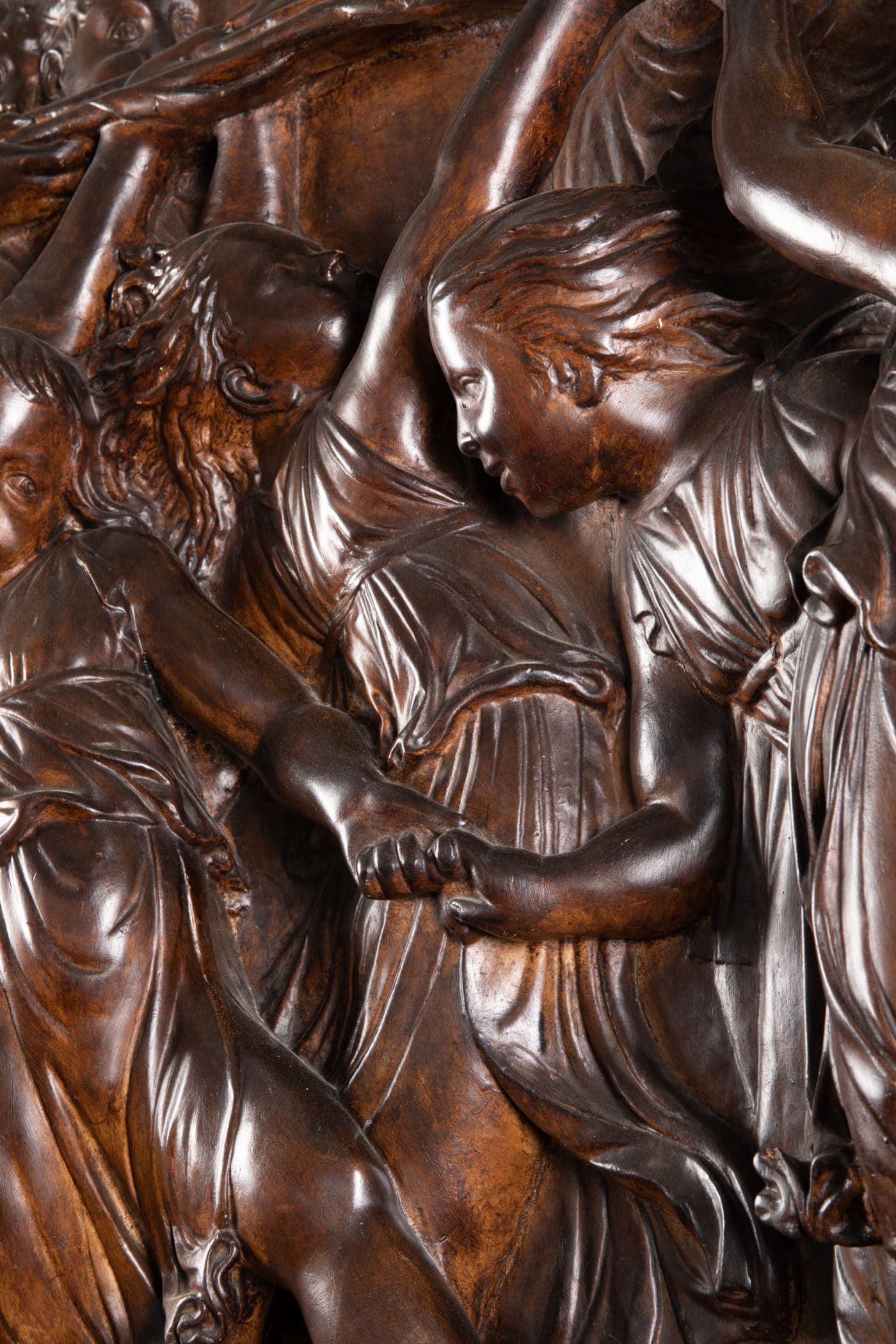
The high, medium and low relief chosen by della Robbia also contribute to this impression of effervescence, the effect is moreover striking when observed a little from the side, as it was from the cathedral of Santa Maria del Fiore by the crowd gathered during religious celebrations.
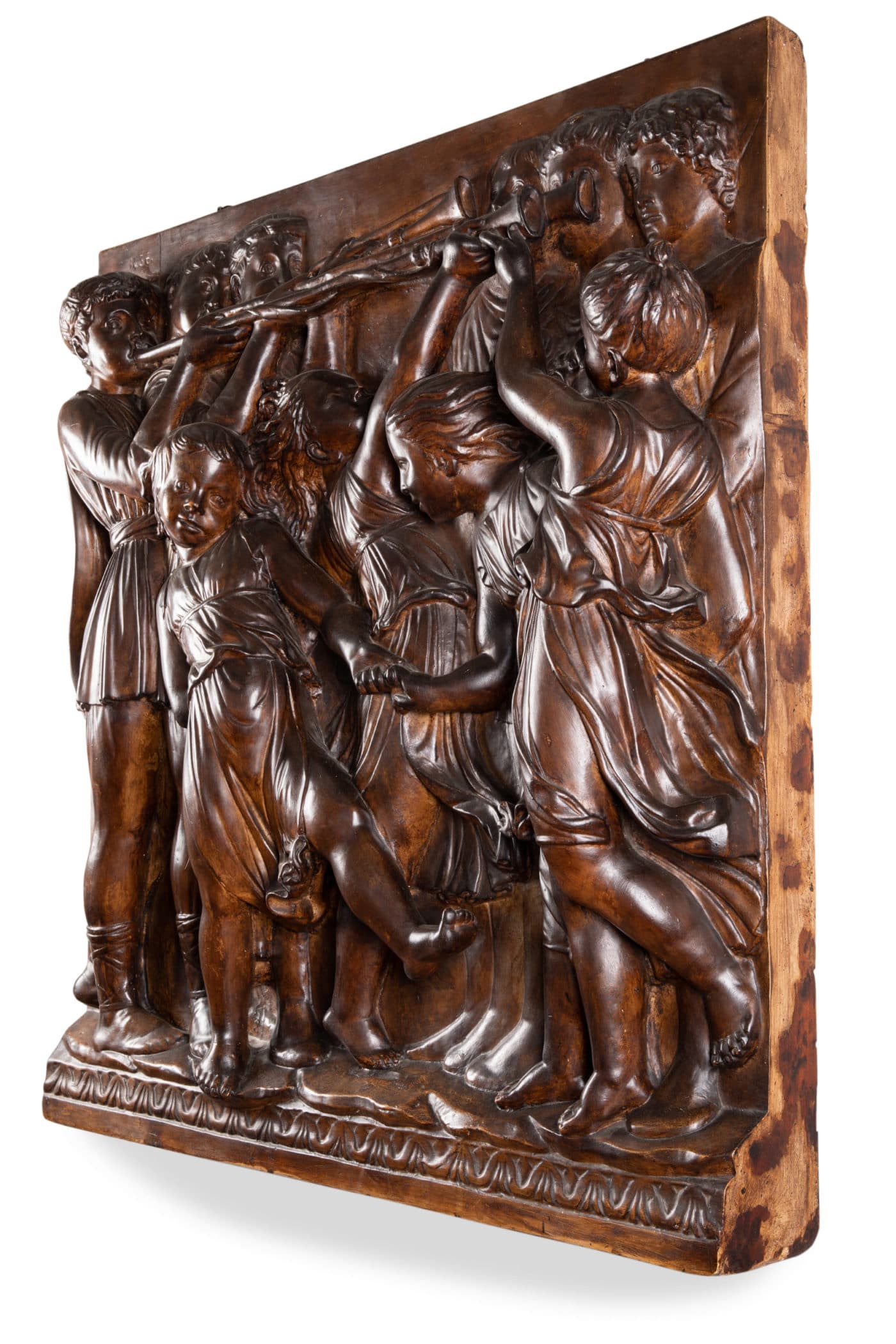
The serenity of the faces, the elegant sobriety of the postures, the light and neat draperies are the guarantee of a perfect reading of the scene. This clear scenography thus takes advantage of the light and plays on its movements throughout the day to animate the scenes imagined and sculpted by della Robbia.
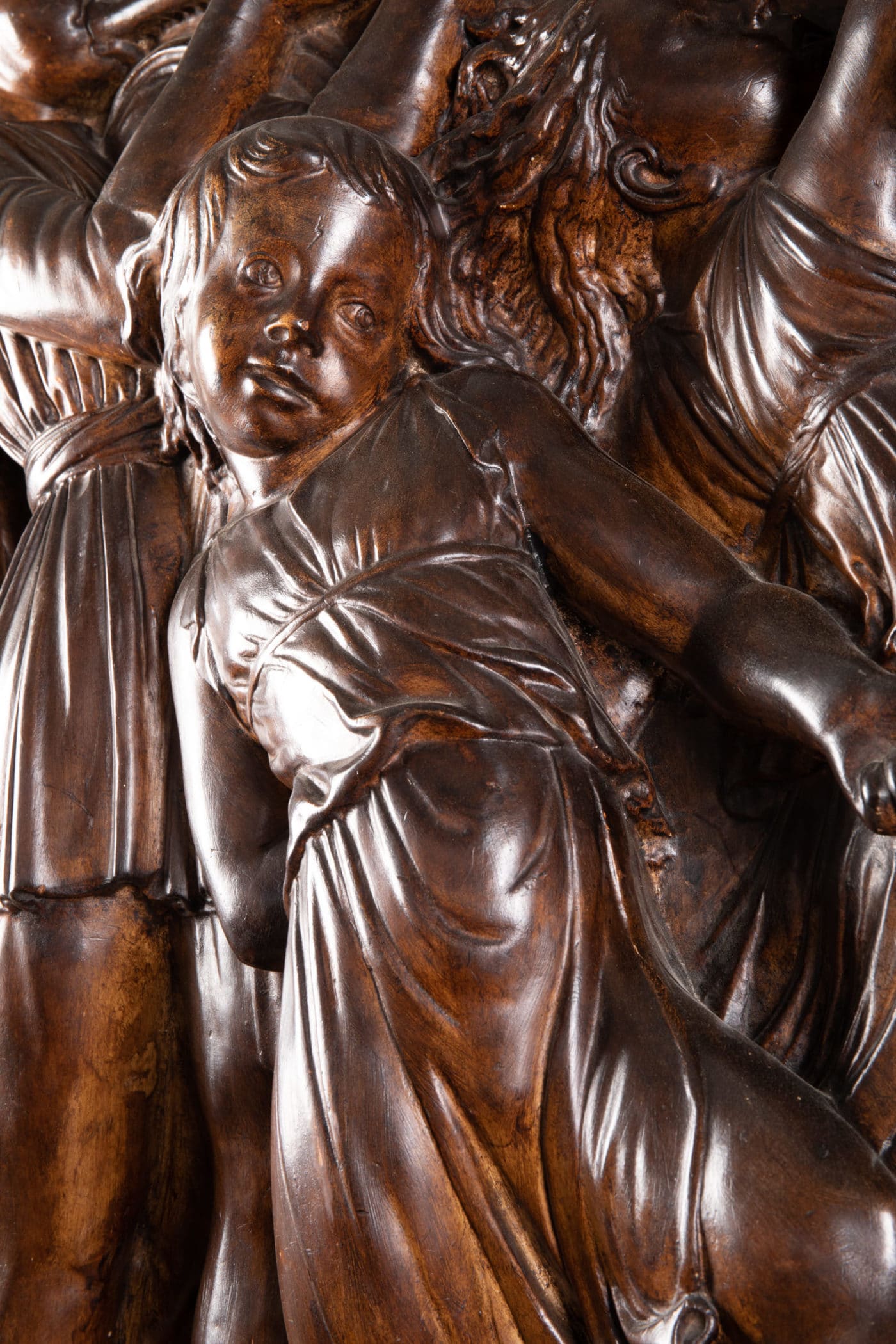
It is quite different from the position taken by Donatello, many of whom consider this work to be surprisingly experimental. His characters engaged in a frantic dance seem quickly brushed, barely sketched.
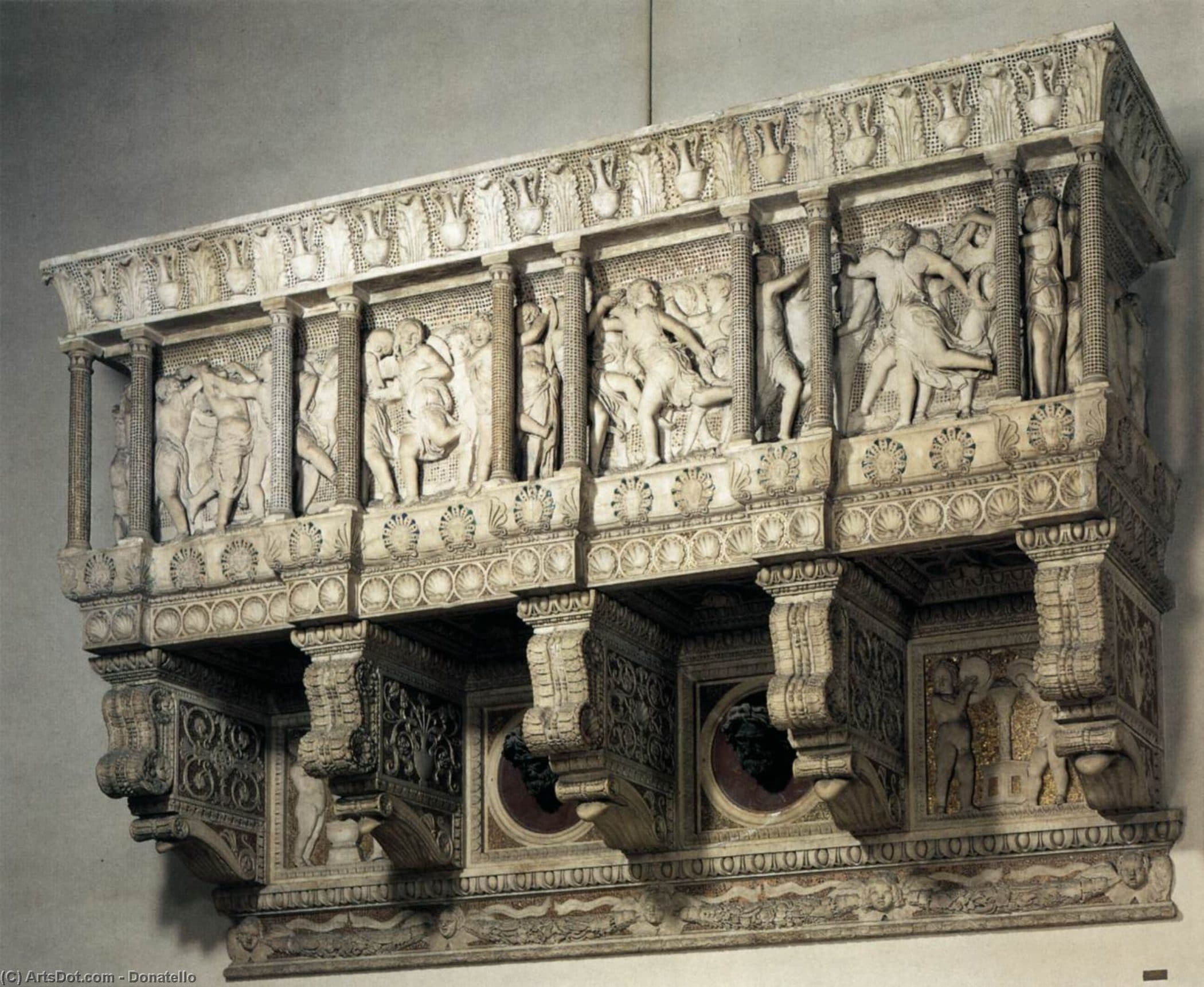
Up close, Donatello’s cantoria appears messy but from a distance, it is a masterpiece. Taking into account the distance of the spectators, Donatello applies to his sculpture the same principles as those applied to the painting of the dome of Santa Maria del Fiore and whose qualities Vasari recognizes:
This artist left his figures almost in outline; he understood that from a distance they would produce much more effect than those of Luca, and that the eye would lose nothing. This deserves all the attention of artists, because experience has proven that a statue or a painting, seen from afar, has infinitely more force and relief if it is largely sketched out than if it is minutely finished. Moreover, the sketches, in the heat of composition, take on a vigorous character which too often disappears under the hands of those who cannot or do not know how to stop in time.
Vasari, Lives of Painters, Sculptors and Architects, Just Tessier, 1841, Volume 1 and Volume 2.
It is therefore fortunate that our plaster chose to reproduce the work of della Robbia rather than that of Donatello! Because if our modern interiors have a comfort superior to that of an Italian cathedral of stone and marble, they do not have its gigantic proportions and prefer to the Dionysiac of Donatello the classical Apollonian clarity of della Robbia.
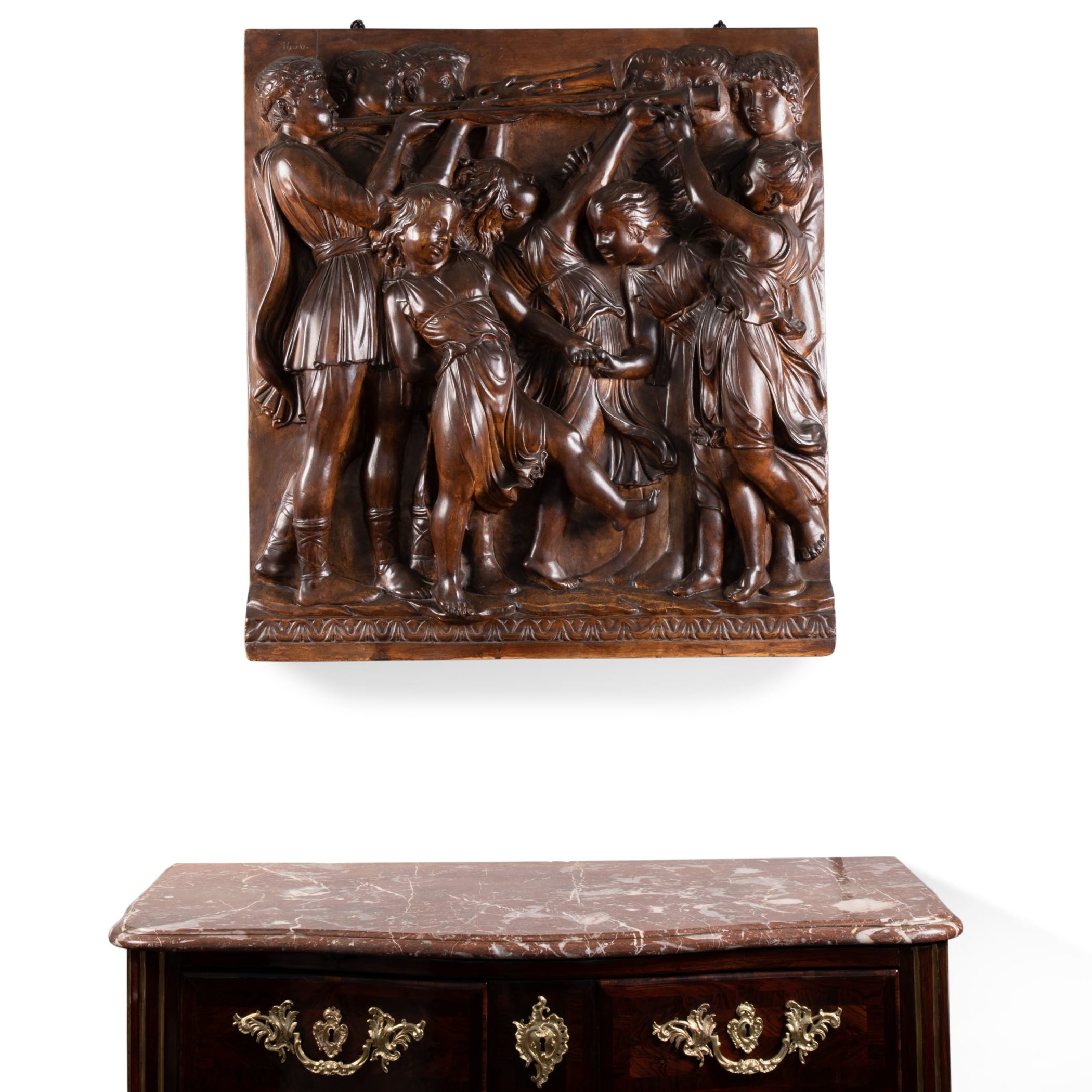
To conclude, remember that Luca della Robbia was not only a brilliant sculptor, he was also a talented ceramist. No doubt the time devoted to his sculpted work in bronze and stone inspired him to try out materials that were less demanding and less costly, in terms of energy as well as investment. This is what Vasari reports, again in Lives:
But when our artist summed up the profits that these works brought him, and the time and fatigue they cost him, he found himself at a loss and resolved to leave marble and bronze to seek some more fruitful profession. He thought that the earth was easily worked, and that it was only necessary to imagine a means capable of preserving works of this kind for a long time. After many attempts, he managed to give them the luster and durability of marble, covering them with a varnish composed of tin, antimony and other minerals and ingredients melted in the fire. By this invention, Luca acquired just claims to the recognition of his contemporaries and of the centuries to come.
Vasari, Lives of Painters, Sculptors and Architects, Just Tessier, 1841, Volume 1 and Volume 2.
Thus, one can imagine quite freely that della Robbia would not have disavowed this beautiful plaster copy, especially since the latter, at a scale of 1:1, betrays neither the volumes nor the composition of this masterpiece of classical art which remained in place for more than two centuries. It was only in 1688, on the occasion of the marriage of Ferdinando de’ Medici, Prince of Florence, Hereditary Grand Duke of Tuscany (1663 – 1713) with Violante-Béatrice of Bavaria (1673 – 1731) that the two choirs were removed. because outdated. They were successively kept at the Galleria degli Uffizi then at the Bargello before being installed at the Museo dell’Opera del Duomo when it first opened in 1891. They haven’t moved since.

Marielle Brie
Art Historian for Art Market and Cultural Media
Author of the blog Objets d’Art et d’Histoire
Autres ressources et documentations
28 June 2025
Plaster Sculptures, Plaster Casts
For a long time, plaster casts suffered from a poor reputation. Often regarded as crude replicas, and sometimes even dismissed as inexpensive imitations, they nonetheless had…
17 April 2025
The Middle-Ages Furniture
Rare and highly sought-after, Middle-Ages furniture is making a strong comeback. An overview of this market, where enlisting the guidance of a professional is strongly advisable.
18 March 2025
Murano Glass Furniture
Since the beginning of the 20th century, Murano glassmakers have been exploring new horizons. After classic lighting and decorative art, Murano glass is now used to adorn…
16 December 2024
A bronze triton after the sculptures of François Girardon (1628 – 1715) in Versailles
This fountain element is all the more admirable as it is sculpted after the masterpieces of the Pyramid Basin, on the parterre of the North Wing of the Versailles gardens.
18 November 2024
Tyco Bookcase, by Manfredo Massironi, for Nikol International
A pure creation of optical art research in the 1960s, the Tyco library shelf designed by Manfredo Massironi invites the viewer to bring the work of art to life on a daily basis.
3 August 2024
The Ocean Liner Style
In the 20th century, the immense ocean liners connecting the Old Continent and the New World were ambassadors of tastes and innovations on both sides of the Atlantic.



